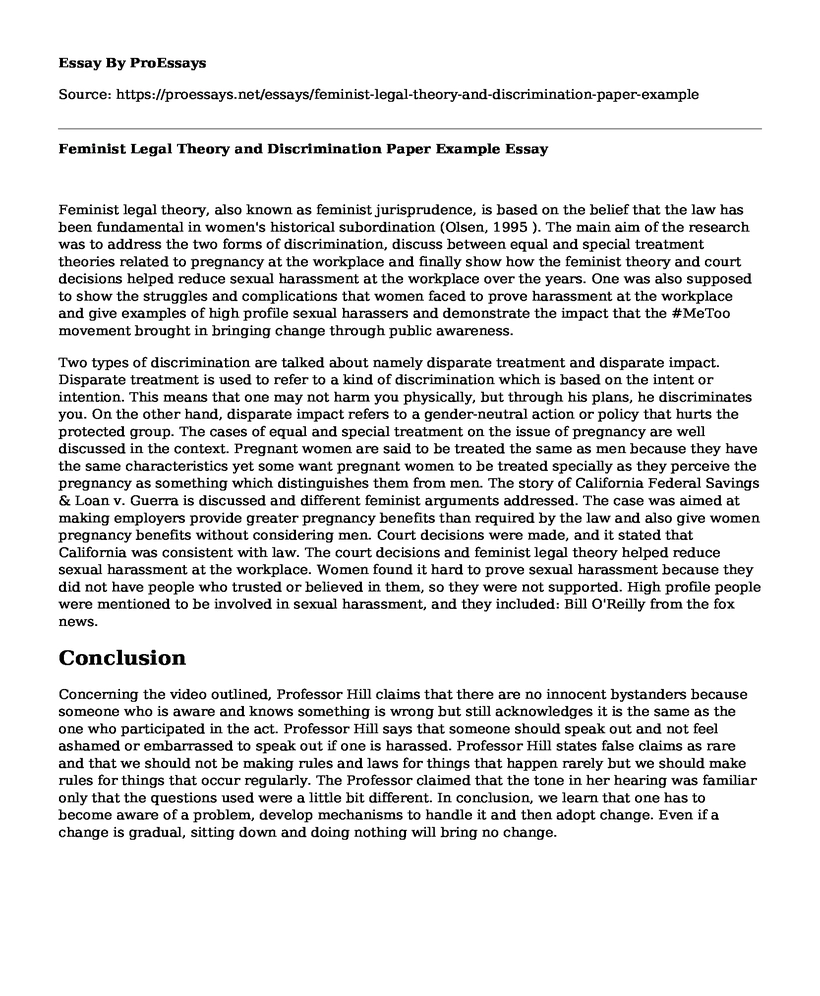Feminist legal theory, also known as feminist jurisprudence, is based on the belief that the law has been fundamental in women's historical subordination (Olsen, 1995 ). The main aim of the research was to address the two forms of discrimination, discuss between equal and special treatment theories related to pregnancy at the workplace and finally show how the feminist theory and court decisions helped reduce sexual harassment at the workplace over the years. One was also supposed to show the struggles and complications that women faced to prove harassment at the workplace and give examples of high profile sexual harassers and demonstrate the impact that the #MeToo movement brought in bringing change through public awareness.
Two types of discrimination are talked about namely disparate treatment and disparate impact. Disparate treatment is used to refer to a kind of discrimination which is based on the intent or intention. This means that one may not harm you physically, but through his plans, he discriminates you. On the other hand, disparate impact refers to a gender-neutral action or policy that hurts the protected group. The cases of equal and special treatment on the issue of pregnancy are well discussed in the context. Pregnant women are said to be treated the same as men because they have the same characteristics yet some want pregnant women to be treated specially as they perceive the pregnancy as something which distinguishes them from men. The story of California Federal Savings & Loan v. Guerra is discussed and different feminist arguments addressed. The case was aimed at making employers provide greater pregnancy benefits than required by the law and also give women pregnancy benefits without considering men. Court decisions were made, and it stated that California was consistent with law. The court decisions and feminist legal theory helped reduce sexual harassment at the workplace. Women found it hard to prove sexual harassment because they did not have people who trusted or believed in them, so they were not supported. High profile people were mentioned to be involved in sexual harassment, and they included: Bill O'Reilly from the fox news.
Conclusion
Concerning the video outlined, Professor Hill claims that there are no innocent bystanders because someone who is aware and knows something is wrong but still acknowledges it is the same as the one who participated in the act. Professor Hill says that someone should speak out and not feel ashamed or embarrassed to speak out if one is harassed. Professor Hill states false claims as rare and that we should not be making rules and laws for things that happen rarely but we should make rules for things that occur regularly. The Professor claimed that the tone in her hearing was familiar only that the questions used were a little bit different. In conclusion, we learn that one has to become aware of a problem, develop mechanisms to handle it and then adopt change. Even if a change is gradual, sitting down and doing nothing will bring no change.
Cite this page
Feminist Legal Theory and Discrimination Paper Example. (2022, Dec 06). Retrieved from https://proessays.net/essays/feminist-legal-theory-and-discrimination-paper-example
If you are the original author of this essay and no longer wish to have it published on the ProEssays website, please click below to request its removal:
- Paper Example on Truth in Sentencing (TIS)
- Age Discrimination in Employment Act of 1967 Essay
- Essay Sample on Tim Wise's Views on Racism and Ethnicity
- Essay Example on Terrorism: Over 100 Definitions and Differences in Opinion
- Essay Example on Critical Infrastructure: Safeguarding Vital Assets for National Security
- Free Case Study Sample on Oil Platform Event: US Response to Iran's Attack in 1987-88
- Free Essay Sample on Images of Pain







